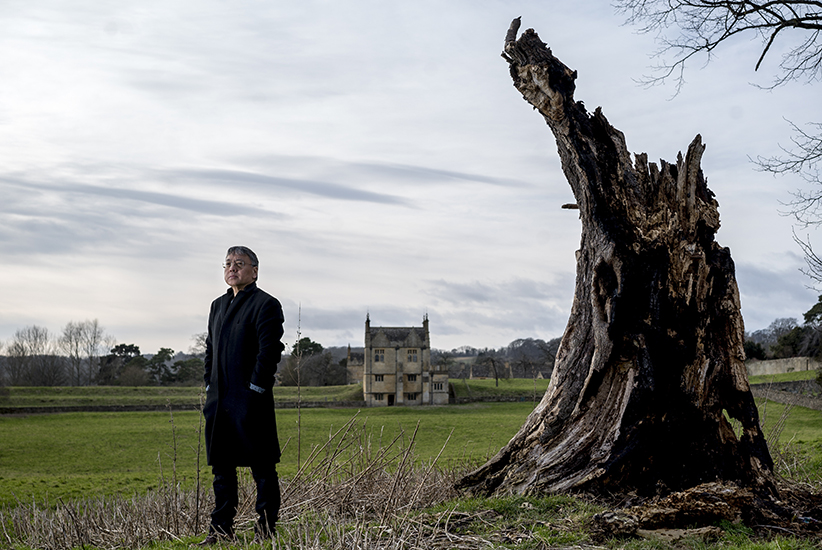Kazuo Ishiguro goes back in time
Ishiguro’s long-awaited novel explores new terrain—and not just because of the ogres
Kazuo Ishiguro, a novelist, in Chipping Campden, England, Jan. 26, 2015. Ishiguro?s new novel, ?The Buried Giant,? is the riskiest and most ambitious venture of his celebrated career, a return to his hallmark themes of memory and loss, set in a ogre- and pixie-populated ancient England. ?I don?t know what?s going to happen,? Ishiguro said. ?Will readers follow me into this?? Andrew Testa/The New York Times/Redux
Share

Kazuo Ishiguro’s new novel, The Buried Giant, features ogres, pixies, a quest to slay a dragon, and a memory-erasing mist that spreads across the English countryside. For fans of his earlier work, this may come as a shock. Ishiguro has previously taken on such weighty issues as Second World War propaganda (An Artist of the Floating World, 1986), the rapprochement between aristocracy and fascism (the Booker Prize-winning The Remains of the Day, 1989), and the ethics of organ-harvesting and cloning (Never Let Me Go, 2005). So what is he doing mucking about in Dark Ages Britain, with magic?
“There’s really difficult baggage in this territory,” admits the Nagasaki-born author, on the phone from his home in north London. “It’s a constant worry. You write something; does that look like Monty Python?” He laughs, but points to his serious aims. Though his book includes one of King Arthur’s knights—Sir Gawain, appearing as an “old gunfighter” figure reminiscent of John Wayne in The Searchers—it’s set at a time of genocide, so a historical theory goes, when the Anglo-Saxons wiped out the Romano-Celtic Britons. The “general setting . . . suggests we are talking about an eternal fact of the human condition”—namely, that the erasure of cultural memory is often how societies keep peace.
Ishiguro’s books usually deal with how people repress or airbrush negative recollections to avoid dwelling on disappointment; his Buried Giant protagonists, Axl and Beatrice, an older Briton couple, remember little about their past or the evolution of their relationship. They set off to find their son, accruing companions along the way: Wistan, a young Saxon warrior with obscure intentions, Edwin, an outcast teenage boy with a wound that suggests evil contagion, and Gawain himself, who seems to recognize Axl as someone who played a part in a conflict generations ago. Where Wistan is determined to find and destroy the source of the mist, Axl and Beatrice come to fear what may happen to the uneasy peace between the Britons and Saxons, should the past come to light.
Here, The Buried Giant becomes political. It brings to mind, for one, the debate over high school history education in some U.S. states, where Republicans are arguing that “what is bad” about their country shouldn’t be taught. “One of the big buried giants for America [is] the memory of slavery and segregation,” says Ishiguro. “Is it going to help race relations to expose the full horror of what was done to African-Americans in the recent past? . . . On the other hand, you could argue that precisely because American society does not look properly at the past, every few months, there’s another riot or act of violence.”
The theme of societal forgetting also evokes what Ishiguro calls “the lesson of the 21st century, that if you get rid of people who look like tin-pot versions of Hitler and Mussolini, something we can’t comprehend breaks out. The case of Egypt and the Arab Spring suggests that even if [revolution comes] from within, the result may be chaos and disorder. [But] what are we saying here? That bad, strong-armed people should remain in place?”
Ishiguro compares the King Arthur in his book to Saddam Hussein: “He’s been ruthless, and he has managed to hold down a peace, but his time will fade, and the thing’s going to start again.”
It’s striking to find a novel that makes us feel ambivalent about the removal of a dictator, and about the very process of uncovering information about its characters—something all novels do. And where The Buried Giant truly moves Ishiguro into new territory isn’t so much in its fantasy elements—which are downplayed—but in its wider sweep. “I feel like I’ve entered an arena for the first time,” says the 60-year-old author, “and I’d like to see what happens if I explore the role of shared memories. It’s a genuinely difficult question in any marriage or long-term relationship.”
He notes that his own wife of nearly 30 years, Lorna MacDougall, will confront him if need be: Upon reading a draft of the first 100 pages, she told him the archaic language was all wrong and made him start over. Some uncomfortable truths, it seems, are better addressed than ignored. “Painful as it is,” he laughs, “it’s worth listening to her.”